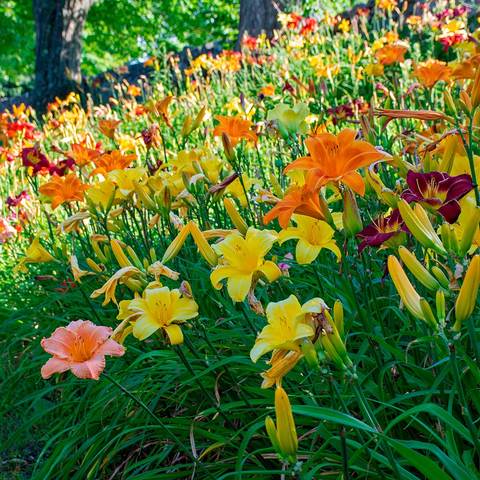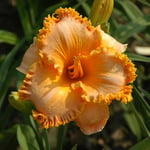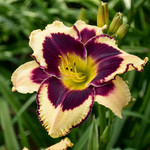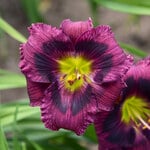Daylily Care
Latin Name: Hemerocallis
Latin Name Pronunciation: hem-er-oh-kal'iss
Of exceptionally easy culture, these long-lived stalwarts of the garden come in every hue but blue. Hardy, pest-resistant, and quick to multiply, Daylilies are ideal perennials with many landscape uses: as specimen plants in the garden or massed to stabilize a slope or to act as a carefree ground cover. Dwarf forms are good container subjects. Although each flower only lasts a day, the blooms open over a long period. Early, mid-season and late varieties are available and by planting some from each group it is possible to have almost continuous bloom throughout the summer. Hybridizers continue to expand the list of reblooming varieties as well.
A Daylily for Every Taste
Whether your taste in flowers tends toward the chaste or the shamelessly flamboyant, there is a Daylily for you. There were, in fact, at last counting some 60,000 distinct Daylily varieties; from this horde, we've selected a diverse but manageable assortment of the very best. If you want trumpets of snowy white with a cool, green throat, you can opt for 'Lady Elizabeth'. If you need a full-blooded, almost black, purple-red, we suggest 'Jungle Beauty'. You'll find every color here other than blue, and if you can't make decisions, you may purchase one of our collections or mixes, which offer a smorgasbord of different hues and flower types.
Growing Daylilies
What We Ship: We ship large, field-grown plants that usually bloom the first year. They will outperform lesser grades offered elsewhere. Except as noted, all are "dormant" varieties, meaning their leaves are deciduous.
Planting: When planting your bareroot Daylily, dig a hole deep and wide enough to accommodate the roots. Spread out the thick roots in the hole and place the plant so the crown—where the leaves meet the roots—is 1″ below the surface of the soil. Holding the crown of the plant, push soil into the hole, working soil around the roots. Firm the soil around the crown, pressing down with both hands.
Light/Watering: Daylilies will grow in full sun in the North and will tolerate the same in the South with sufficient moisture. Plants grow well in partial shade, which is preferred for varieties with pastel flowers. Daylilies are drought-tolerant once established, but perform best with consistent moisture.
Fertilizer/Soil and pH: These perennials prefer a well-drained loam with a pH approaching neutral. Soils rich in organic matter encourage profuse blooming, although many of the older hybrids will grow well even in a sandy situation. Fertilize lightly once the plants are established, but avoid using mixes high in nitrogen. A summer mulch is appreciated, since it will help soils retain moisture and buffer soil temperatures.
Pests/Diseases: Daylilies rank high on the list of plants resistant to insects and diseases. Thrips occasionally feed on buds or flowers, distorting the blooms and causing cork-like lesions on the flower spikes, which may then break at the affected area. Use insecticidal soap to discourage these tiny pests, and remove and destroy any infested buds or flowers. Spider mites can infest the foliage during hot, dry weather; wash them off with a forceful water spray regularly, or use an appropriate insecticide. Yellowing leaves and brown leaf tips result from normal senescence after flowering; regular grooming will keep plants looking fresh. If foliage becomes unsightly, cut it back to the ground, water well, and in time new foliage will appear.
Companion Plants: Platycodon, Rudbeckia, Liatris, Shasta Daisy, and Echinacea are all fine companions for sunny situations; Ferns, Hosta, and Solomon's Seal are lovely with Daylilies growing in shadier spots. If you underplant Daylilies with Daffodils, the foliage of the former will hide the foliage of the latter as it dies back, and you'll get two gorgeous seasons of bloom from one area with very little maintenance.
Reflowering: Many reblooming varieties are now available; these require regular removal of old flowers to perform at their best. On all types of Daylilies, spent flowers should be snapped off daily and the entire flower scape should be cut off after all buds have passed.
Dividing/Transplanting: Daylilies should be divided every three to five years, and repeat-bloomers every two years since new growth supports the rebloom. Two spading forks held back-to-back and prised apart makes this chore easy. Transplant anytime the soil is workable, watering well after planting in the new location.
Calendar of Care
Early Spring: Apply a light application of balanced or slow-release fertilizer low in nitrogen or side-dress with compost and organic amendments when new growth appears. Divide or transplant as necessary, watering well afterward.
Mid-Spring: Water well if it is unseasonably dry, as plants prefer evenly moist soil.
Late Spring: Remove spent flowers daily. Watch for flower thrips and treat accordingly.
Summer: Continue to deadhead as needed, and cut away flower scapes after all buds have opened. Groom plants by removing yellow or dead leaves. Supplement natural rainfall to provide an inch of water a week, and apply 2–3 inches of mulch around plants, keeping it an inch or so away from the crowns. Monitor plants for spider mites and spray if needed.
Fall: Simply remove old foliage by cutting back to the ground. Daylilies are very cold hardy, with the exception of some evergreen varieties, so a winter mulch is little more than a nicety.
Frequently Asked Questions
When to plant Daylilies?
The best time to plant Daylilies is in the late spring or early fall (several weeks before the first anticipated frost) though it's possible to plant them any time during the growing season.
Do Daylilies spread?
Daylilies tend to spread quickly on their own, given the opportunity in the form of open space. To prevent them from taking over your garden, it's prudent to divide them regularly, as we describe above.
Why are my Daylilies not blooming?
The most common reason for Daylilies not blooming is insufficient light. Another typical reason for lackluster blooms is overcrowding–which can be addressed by regularly dividing your Daylily plants.
How far apart to plant Daylilies?
Plant your Daylilies at least 12 to 18 inches apart to ensure they have adequate room to grow and thrive.
How tall do Daylilies get?
We offer a wide variety of Daylilies that range in height at maturity from one to three feet.
What to do with Daylilies after they bloom?
As each Daylily bloom fades, pinch off the spent flowers to keep the plant looking its best as it otherwise continues blooming. When all blooms are spent, cut the flower stems off at the base of the plant with pruning shears to continue to enjoy the foliage and encourage reblooming for reblooming varieties.
Can I grow Daylilies in containers?
You can grow our Daylilies in one gallon or larger sized containers. Be sure to use high quality planting soil mixed with compost.
Daylily Growing Tips
Shop All Daylilies






